A BRIEF HISTORY OF THE GRIMSBY ICE FACTORY
The Grimsby Ice Factory is a unique heritage asset, of international importance, situated on Grimsby’s historic dock peninsula.

THE EXPANSION OF THE FISHING TRADE
With the arrival of the railway in 1848, and the development of Grimsby Docks – beginning with the Royal Dock in 1852 – came a rapid expansion of the fishing trade. The need for ice, to supply the merchants and fishing boats, could barely be met by small local manufacturers and imported ice from Norway. The Grimsby Ice Company was formed, and plans were made to build the Grimsby Ice Factory.
Begun in 1900, and extended in 1910, at its peak in the 1950s the Grimsby Ice Factory was producing up to 1200 tons of ice every day. This capacity to preserve the freshness of the catch helped to make Grimsby the busiest fishing port in the world. It is no exaggeration to say that the fortunes of the town during this period depended upon the Grimsby Ice Factory.
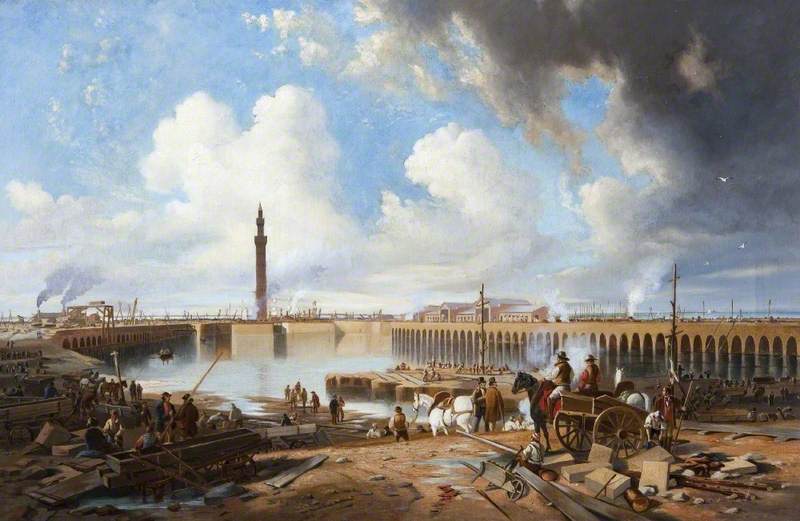

THE SCIENCE
The factory first used steam to power the Pontifex (and later Linde) Ammonia compressors which made the ice. As demand for ice increased, two more tank rooms were added, between 1907 and 1910. In 1930, a modernisation programme began. Metropolitan-Vickers of Manchester was commissioned to provide new electric generators and J & E Hall of Dartford, Kent won the contract to replace the refrigeration equipment. The factory expanded once more in the early 1950’s, with a seventh tank room being built.
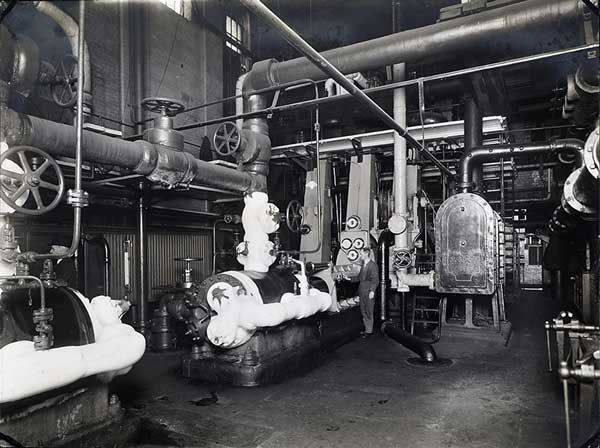
OWNERSHIP
The original owner, the Grimsby Ice Company, was an amalgamation of the Great Grimsby Ice Company and the Grimsby Co-operative Ice Company. The company maintained ownership for the next seventy years, when the factory was transferred to a sister company, The Grimsby Exchange, Ltd.
As technology changed, and the fishing fleet was reduced, the need for block ice declined. Production at the Ice Factory gradually diminished, and the factory closed in 1990. At that time, ownership of the factory reverted to the landowner, Associated British Ports (ABP), who had acquired Grimsby and Immingham Docks in the 1980‘s when the British Transport Docks Board was privatised.
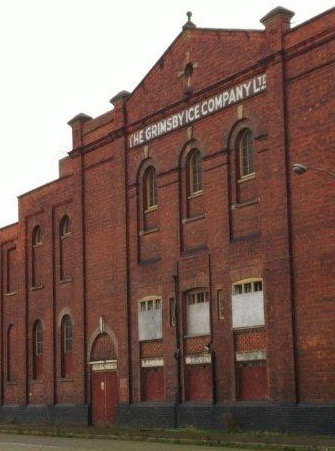
THE HERITAGE
The Grimsby Ice Factory is a unique survivor of the Victorian industrial era. This gigantic ice-making machine, with a footprint of over an acre, is thought to be the earliest and largest known surviving ice factory in the world, and the sole survivor from this period to retain its machinery. It is possible, touring the building, to trace the entire ice-making process as carried out in the early 20th century. Notwithstanding its solely practical purpose, the factory was built with an attention to detail worthy of the best Victorian industrial architecture, and now this imposing brick building, with its recessed arched bays, pediments, and other extravagant features, awaits restoration. But for the efforts of local activists, it would have been demolished soon after closing in 1990.
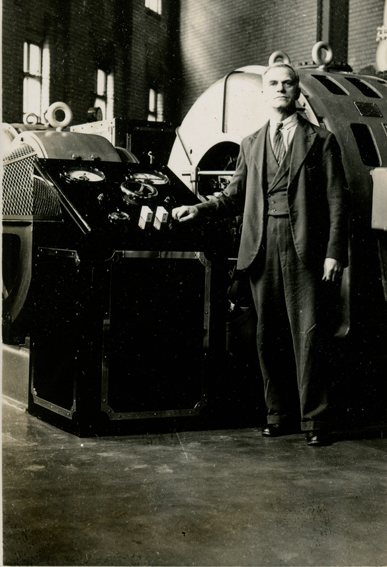
PRESERVATION
In September 1990, at the instigation of local architect Rex Critchlow, the Grimsby Ice Factory buildings were spot listed as Grade II. ABP subsequently applied to English Heritage to have the preservation order lifted, to allow them to demolish the buildings. The result was a review of the listing, and an upgrade to Grade II* on 12, August 1993.
Since then the building has been abandoned and not maintained. It has been identified as a building at risk on the English Heritage “Heritage at Risk” register since 1992 where its condition is now described as ‘very bad’ and it is priority assessed as A – the highest priority for action. As a result of this neglect, it suffers from an ever worsening condition. The roof is open to the elements, so rainwater “cascades through the buildings from top to bottom.” (Purcell, Miller Tritton). Thieves have stripped whatever metal they can find – in particular the copper from the cupola, and from the electrical fittings. According to Alan Baxter Associates, who completed an appraisal of the structure in 2010, the buildings had missed their last two major overhauls, and were now deteriorating at a rapidly increasing rate. Such was the state of parts of the buildings that in 2007 they made the ideal setting for scenes in war-torn Dunkirk, for the film “Atonement.” The intervening years have only exacerbated the situation.
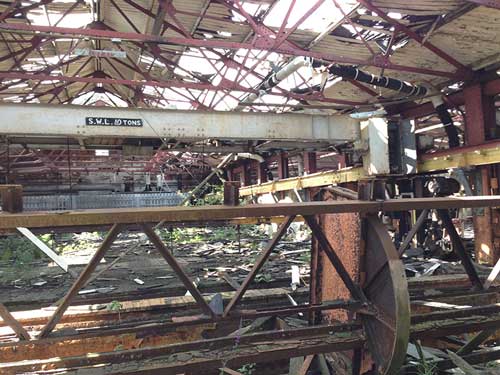 The upper floor of the 1901 building
The upper floor of the 1901 buildingRE-USING THE BUILDING
During the 1990’s, following advice from a Conservation Consultant, ABP actively marketed the buildings for sale, and there was interest from two local entrepreneurs. Unfortunately, neither of the schemes progressed, and the buildings continued to deteriorate.
In 2010 North East Lincolnshire Council (NELC) and ABP jointly commissioned the structural appraisal referenced above, and a Conservation Statement (a summary of the heritage value of the building and its contents), with a view to re-opening the case for demolition. A public meeting was organised by the Grimsby, Cleethorpes & District Civic Society to gather local views, which revealed that about equal numbers of concerned residents supported either getting rid of the “eyesore” that the factory had become, or preserving the building for future generations. In July of that year the Great Grimsby Ice Factory Trust (GGIFT) was formed with the purpose of finding a sustainable new use for the Ice Factory. Since then the building has had the support of numerous organisations including The Prince’s Regeneration Trust, SAVE Britain’s Heritage, The Council for British Archaeology, The World Monuments Fund, The Victorian Society and Europa Nostra. The Ice Factory has featured in numerous publications, radio and television shows, and attracted national and international attention by being included in the following lists:
- Victorian Society Top Ten Endangered Buildings 2010 (https://victoriansociety.org.uk/news/category/2010-top-ten)
- World Monuments Fund 2014 Watch (http://wmf.org.uk/project/the-watch/)
- Europa Nostra 7 Most Endangered 2018 (http://www.europanostra.org/europe-7-most-endangered-heritage-sites-2018-announced/)
In 2013 GGIFT raised funds to commission an options appraisal, which served as the basis for a bid to the Heritage Lottery Fund (HLF) to fund a mixed-use development that would have secured the future of the building, but unfortunately the bid was not successful.
In 2018 the Ice Factory was included within the boundaries Historic England’s new Greater Grimsby Heritage Action Zone (HAZ), a five year programme that will support the preservation of Grimsby’s heritage buildings, and, in partnership with NELC and ABP, specifically bring funding to the historic dock area.
Great Grimsby Ice Factory is undoubtedly one of the most significant pieces of industrial heritage in the north of England. With numerous other examples having already been lost nationwide, this vast building, with its still extant ice-making machinery, is the last of its kind.
It is easy to forget how reliant we are on mechanical refrigeration for our continued existence on this planet. Refrigeration is essential for food storage and distribution, indispensable in many industrial processes, and is vital in modern medicine for the preservation of organs for transplant, blood plasma storage and production and storage of drugs.
The J. & E. Hall refrigeration compressors still in place at the Grimsby Ice Factory are a reminder of the early years of refrigeration. They are the oldest of their type still in existence and amongst the largest ever made. As a record of the history of the modern world, the ice-making equipment within the Grimsby Ice Factory is an essential and irreplaceable artefact.
The former Grimsby Ice Company factory is an irreplaceable piece of our industrial refrigeration history. The factory is an early link in the supply chain that insures safe, high quality perishable foods to developed countries. It is a reminder of the continuing effort to provide a secure “cold chain” in the developing world where the loss of harvested fruits, vegetables, meat and fish often exceeds 40% due to the lack of proper handling and continuous refrigeration.
The Grimsby Ice Factory is the only remaining building of its type in the UK. It houses Britain’s last surviving samples of early 20th century refrigeration equipment. If the building is demolished, it will deprive us of a rare opportunity to see this equipment in its original setting.
The ice factory buildings are of interest because they offer an insight into the heart of the industrial activity in the docks in their heyday.
The installation represents the peak of development of large industrial ice making equipment and includes the only known surviving examples of large size J&E Hall ammonia compressors of this type. From this point on the refrigeration industry developed smaller, faster running machines and following the depression of the 1930s and the Second World War the fishing industry moved away from shore-made ice towards large freezer trawlers.
